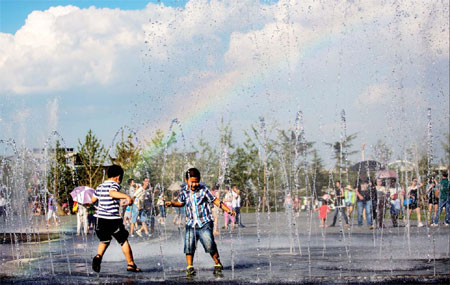Searching for answers for better air
Updated: 2013-10-18 09:45
By Wu Wencong and Jiang Xueqing (China Daily Europe)
|
|||||||||||
Quest for clear skies prompts China to cut coal use and find other energy sources
Reducing coal usage, cutting emissions and the desire for clean technologiy seem to be the prime reasons why China has been stepping up its nuclear power generation plans, experts say.
At the same time, the government has also come out with several new policies and financial support packages, all of which are aimed at having clear skies over China before 2017.
The government has set up a 5-billion-yuan ($820 million; 602 million euros) special fund designated for airborne pollution control and management work in the Beijing-Tianjin-Hebei cluster, the Inner Mongolia autonomous region, Shandong and Shanxi provinces.
The Ministry of Environmental Protection has earmarked 1 billion yuan for scientific research on airborne pollution as part of its efforts to understand how smog and haze are formed and how pollutants move in the air.
Most of the efforts, however, are for development of alternate energy sources, reducing coal consumption and promoting low-sulfur fuels.
According to experts, the task of finding an alternative to coal, the most widely used energy source in China, may not prove that easy, but it seems to be the one that needs to be taken seriously as air pollution is worsening in many northern Chinese cities.
In Beijing, coal usage contributes to 20 percent of the primary pollutants PM2.5, particles up to 2.5 microns in diameter, small enough to enter the lungs and blood stream. That figure rises to approximately 30 percent if emissions of sulfur dioxide and nitrogen oxide, which can produce PM2.5 during the burning process, are taken into consideration, says Jiang Kejun, senior researcher at the Energy Research Institute of the National Reform and Development Commission.
China will reduce its consumption of coal and gradually increase the use of natural gas and non-fossil fuel energy during the next few years, according to the Airborne Pollution Prevention and Control Action Plan (2013-17), which was released by the State Council on Sept 12.
In 2011, China's total energy consumption was 3.48 billion metric tons of standard coal equivalent, out of which coal consumption contributed 68.4 percent, while natural gas contributed just 5 percent, according to the National Bureau of Statistics.
In 2012, China consumed nearly 2.5 billion tons of coal, more than all other countries combined, according to the Ministry of Environmental Protection.
The government has decided to reduce the amount of coal being burned to less than 65 percent of total energy consumption by 2017, while consumption of natural gas will rise to 7.5 percent of the total by 2015.
Between 2011 and 2015, 44,000 kilometers of natural gas pipelines will be built, raising the annual receiving capacity of liquefied natural gas terminals in the coastal regions by more than 50 million tons, according to the 12th Five-Year Plan on Energy Development (2011-15).
Natural gas pipeline capacity will rise by 150 billion cubic meters by 2015, and urban residents will have priority use of the power generated by the newly added supply.
Hebei and Shandong provinces and the municipalities of Beijing and Tianjin will cut their combined coal consumption by 83 million metric tons by the end of 2017, according to a regional air-pollution control plan.
The plan, released by the Environmental Protection Ministry on its official website on Sept 23, sets targets for six municipalities, provinces and autonomous regions in and around the Beijing-Tianjin-Hebei cluster.
The region, plus Liaoning province, consumes 43 percent of the country's coal, produces more than half the country's steel and suffers the most severe air pollution.
The regional plan aims to reduce the concentration of PM2.5 by about 25 percent from 2012 levels in Beijing, Tianjin and Hebei; by 20 percent in Shanxi and Shandong provinces; and by 10 percent in the Inner Mongolia autonomous region.
Measures that will achieve the goals include effectively reducing production capacity in many industries and controlling total coal consumption within the region.
In the steel industry, for example, Hebei will have to reduce its production capacity by at least 60 million tons by 2017. Shandong will need to trim its production capacity by 10 million tons by 2015. The two provinces will also reduce their coal consumption by a combined 62 million tons in five years, accounting for almost 75 percent of the regional target.
The 60-million-ton quota has been allocated to cities and enterprises before October, says Chen Yongjiu, director of the Hebei Development and Reform Commission.
"Hebei will cut the province's coal consumption by 40 million metric tons by 2017," Chen says. "The gap will be filled with electricity originating from outside the province, plus natural gas and renewable energy such as wind and solar power."
He says Hebei has the natural conditions to develop wind power. Its current production capacity is 10 million kilowatts.
As one of the biggest coal producers and consumers in China, Shandong has both the capacity and the obligation to reduce emissions, says Qiao Naizhen, director general of the Shandong coal industry bureau.
"I think coal enterprises should make efforts to readjust their industrial structure to seek sustainable growth, develop some coal-related emerging industries, such as coal equipment manufacturing, modern logistics and high-end services," Qiao says.
According to the plan, coal consumption, as a proportion of Beijing's energy mix, will drop from its current mark of 25 percent to less than 10 percent by 2017.
"As air pollution has become a serious problem in China, and attracts unwelcome attention worldwide, it's inevitable that coal will be replaced by natural gas. However, the low price means major state-owned oil firms are unenthusiastic about exploring natural gas," says Yang Fuqiang, senior advisor on climate and energy at the Natural Resources Defense Council.
For example, it costs 3.5 yuan ($0.6; 0.4 euros) per cu m to import natural gas from Central Asia to gas stations in Beijing, but the stations can only sell the gas to residents at a government-regulated price of 2.05 yuan per cu m. The loss of 1.45 yuan per cu m is covered by government subsidies, according to Yang.
"Reform of the price of natural gas is not a one-step process. On the contrary, it should move forward in small, quick steps to avoid damaging sustainable consumption," says Chen Weidong, chief energy scientist at the Energy Economics Institute of China National Offshore Oil Corp.
In the long run, as the pipeline network is expanded to cover more regions, steep rises in the cost of natural gas will cease, according to Zhou Dadi, vice-chairman of the China Energy Research Society.
"It's just that for now, the cost must rise to allow the industry to develop, but it will reach a balanced stage later on. Then we will be able to discuss the possibility of lowering the cost," he says.
Another key factor that affects the Beijing-Tianjin-Hebei cluster's air quality is traffic. Public transportation will carry at least 60 percent of Beijing and Tianjin's passengers by the end of 2017, the plan said.
The regional plan specifically emphasized the importance for the country's three major fuel providers - Sinopec, China National Petroleum Corp and China National Offshore Oil Corp - to supply high-quality fuel with low sulfur content to the region on schedule.
The plan also asked several cities, including Beijing, Tianjin and Shijiazhuang, to implement policies such as subsidies to encourage taxi drivers to upgrade their vehicles' exhaust purification devices.
"Taxis are perhaps the most frequently used automobiles in cities, running more than 100,000 kilometers every year and emitting large amounts of pollutants into the air," says Ding Yan, deputy head of the Environmental Protection Ministry's vehicle emissions control center.
The success in meeting the targets will be evaluated every year by a special assessment team formed by the government and third parties, says Wang Jian, deputy head of the ministry's pollution prevention and control department.
Contact the writers at wuwencong@chinadaily.com.cn and jiangxueqing@chinadaily.com.cn
|
Children play by the fountains at the ninth China International Garden Expo in Beijing in August. The city has been hit by severe smog since early this year. Mao Yanzheng / China Daily |
(China Daily European Weekly 10/18/2013 page23)
Today's Top News
Scientists requested government to plant GM crops
Travelers to Europe bypass attractions of Brussels
Li urges greater effort on reforms
'Constructive ideas' on thorny issues needed
US deal key to nabbing fugitives
JPMorgan, DOJ reaches $13b deal
As China's economy grows, so does reform call
Expanded property tax trials predicted
Hot Topics
Lunar probe , China growth forecasts, Emission rules get tougher, China seen through 'colored lens', International board,
Editor's Picks

|

|

|

|

|

|






